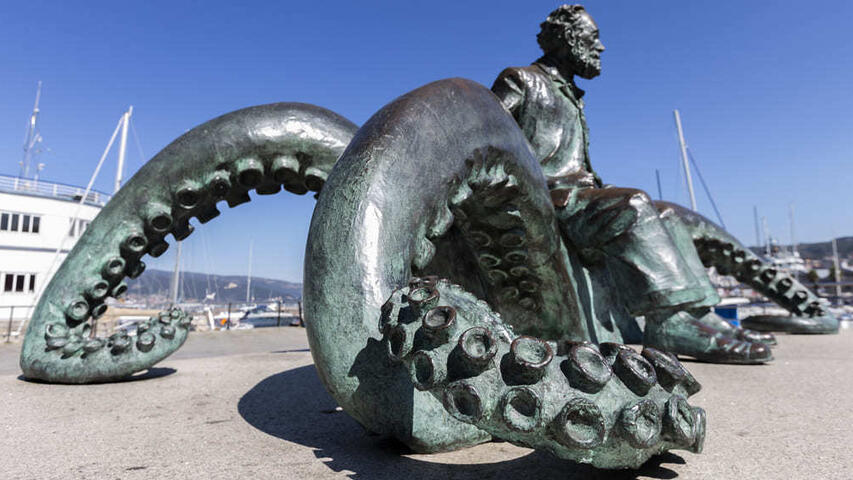Literature
Inspiring landscapes
The Rías Baixas have been a literary muse and setting since the Middle Ages.
The Vigo estuary inspired the Galician medieval troubadours and Jules Verne. Emilia Pardo Bazán found a haven of peace to write in the Mondariz spa and in the lands of Deza, just as María Vinyals found the ideal atmosphere to let her imagination fly in the castle of Soutomaior, where she ran around as a child and to which she invited great figures of the time.
Life in Vila de Cruces was the main source from which Xosé Neira Vilas drank. Vilanova de Arousa saw the birth and spurred the creativity of Ramón María del Valle-Inclán, as well as the talent of Francisco and Julio Camba. Bernardino Graña, the poet of the sea, sang of the fishermen of Cangas and the strength and immensity of the landscape of O Morrazo; and an unbreakable umbilical cord links Cambados with Ramón Cabanillas, whose sculpture observes the horizon seated on a bench in the town.

Pontevedra and Vigo have historically been, and still are today, hotbeds of writers.



Castelao spent the central years of his life in Pontevedra, which was then experiencing one of its great periods of intellectual effervescence. Cantares Gallegos, a work that would mark the Rexurdimento of the Galician language, was printed in 1863 in Vigo. Both cities were historically and to this day hotbeds of writers, some of whom were born in Vigo and others who came from different places, all of them imbued with its rich literary atmosphere.
The idyll of the province of Pontevedra with the world of literature covers all its corners. The list of creators born in As Rías Baixas extends from the Middle Ages to the present day, and personalities from other provinces and latitudes lived here fundamental or central episodes of their lives. Álvaro Cunqueiro, María Victoria Moreno, Carlos Casares, Agustín Fernández Paz and a long list of creators are more than illustrious Pontevedra natives.
Others have their roots here, such as the Brazilian Nélida Piñón, with origins in Cotobade. And the short stays also left their mark on great universal writers. In Verne, who made the treasures of Rande known to the world; or in Julio Cortázar, who bathed "like Poseidon" in Nigrán. A land that breathes literature in its idiosyncrasy, culture and magical landscapes.
Vigo sails on the Nautilus
The legend of the galleons sunk in Rande inspired Jules Verne for his novel 20,000 Leagues Under the Sea. "Well, Mr. Aronnax, we are in the Bay of Vigo and it is up to you alone to discover its secrets". With this sentence, and on board the "Nautilus", Captain Nemo invites his prisoner, the biologist Pierre Aronnax, to participate in the recovery of the gold submerged in the estuary in 1868. More than a century and a half later, the sculpture by José Molares, next to the island of San Simón, recalls the presence of Vigo in the work of the brilliant writer.
